Reviews: Read What Christian Fisanick Is Saying: page 2
17 ★★★★★ reviews
12 ★★★★★ reviews
1 ★★★★★ reviews
The Amazing Memory Test
Overall customer rating: ★★★★★reviewed by Christian Fisanick (confirmed purchase)
Rating: ★★★★★ (Date Added: Monday 19 September, 2016)
 This is Luke Jermay's take on Corinda's Step 3 Amazing Memory Test. While anything Luke Jermay says is worth reading, I'm not sure this is worth $25. First, Jermay has some ideas on adapting Corinda's objects to make them more personal and vivid. This is the kind of memory stuff that you can find elsewhere and was not of much use to me since long ago I'd committed Corinda's system to memory without change. Jermay's discussion of how to do a memory routine was useful, however, as was his idea to link it with a backward alphabet recitation. (Though I disagree with him on how to do that parlor trick. Get Devin Knight's fantastic, inexpensive book with great mnemonics from Lybrary, and you'll be able to recite the alphabet backward in under an hour of study. No kidding.)
This is Luke Jermay's take on Corinda's Step 3 Amazing Memory Test. While anything Luke Jermay says is worth reading, I'm not sure this is worth $25. First, Jermay has some ideas on adapting Corinda's objects to make them more personal and vivid. This is the kind of memory stuff that you can find elsewhere and was not of much use to me since long ago I'd committed Corinda's system to memory without change. Jermay's discussion of how to do a memory routine was useful, however, as was his idea to link it with a backward alphabet recitation. (Though I disagree with him on how to do that parlor trick. Get Devin Knight's fantastic, inexpensive book with great mnemonics from Lybrary, and you'll be able to recite the alphabet backward in under an hour of study. No kidding.)
I liked the material here, especially for someone who hasn't studied the Corinda step. (But why haven't you?) But it's just not worth the price.
The Best Short Change Scam Ever
Overall customer rating: ★★★★★reviewed by Christian Fisanick (confirmed purchase)
Rating: ★★★★★ (Date Added: Monday 19 September, 2016)
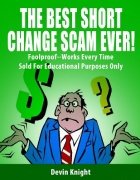 If you've ever seen the movie The Grifters, you will see John Cusack do a version of the short change scam. As Devin reminds us, this ebook is for educational purposes only because if you pull this routine on a shopkeeper, you are stealing, plain and simple. I've seen it used exactly one time in my life, many years ago, so I'm sure that there still are some practitioners of this out there. This ebook should probably be required reading for anyone who works in retail or at charity events. The short change is an insidious flim-flam.
If you've ever seen the movie The Grifters, you will see John Cusack do a version of the short change scam. As Devin reminds us, this ebook is for educational purposes only because if you pull this routine on a shopkeeper, you are stealing, plain and simple. I've seen it used exactly one time in my life, many years ago, so I'm sure that there still are some practitioners of this out there. This ebook should probably be required reading for anyone who works in retail or at charity events. The short change is an insidious flim-flam.
How Psychics Locate Missing People
Overall customer rating: ★★★★★reviewed by Christian Fisanick (confirmed purchase)
Rating: ★★★★★ (Date Added: Monday 19 September, 2016)
 For $10 and 12 pages, I was intrigued, so I bit. And five minutes later, after finishing this ebook, all I could do was shake my head at a scam so ingenious, yet so diabolical, that I'd never have come up with it on my own in 10 lifetimes. Of course, I'm not a con artist. Anyway, you are getting a really obscure--and dangerous--phony psychic scam, one that if you do it, you will be committing a serious federal crime. It's an interesting read, but you have been warned. (Devin warns you too.)
For $10 and 12 pages, I was intrigued, so I bit. And five minutes later, after finishing this ebook, all I could do was shake my head at a scam so ingenious, yet so diabolical, that I'd never have come up with it on my own in 10 lifetimes. Of course, I'm not a con artist. Anyway, you are getting a really obscure--and dangerous--phony psychic scam, one that if you do it, you will be committing a serious federal crime. It's an interesting read, but you have been warned. (Devin warns you too.)
Phenomental!
Overall customer rating: ★★★★★reviewed by Christian Fisanick (confirmed purchase)
Rating: ★★★★★ (Date Added: Monday 19 September, 2016)
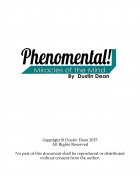 It's almost de rigueur in the mentalism field to put out a book, usually with nine effects, and slap a price tag of $30 on it. And the old adage goes that if you find at least one thing that you'll use, it was a good purchase. I have mixed feelings about Phenomental. First, you get eight effects, but it's more like five effects and three forces/subtleties, not full routines. I'm going to have to try out Vaporize even though I'm not a fan of dual reality. The Up Force is intriguing, like something that should be in Banachek's next volume of Psychological Subtleties. I think Influenza is the strongest routine here, though truth be told, it's a variation on an old Annemann idea, one that Looch and now Alexander Marsh have also gussied up. (And the video performance of it, in front of what appears to be a women's lavatory at a park, is completely underwhelming, especially since it edits out the move that you need to do.) The other stuff, like yet another handling of Out of this World and the WatchStop Principle, which is hardly original, really didn't do anything for me. I will say though that I was impressed that a few things actually used sleights, something that you don't see much of in mentalism, and that's good.
It's almost de rigueur in the mentalism field to put out a book, usually with nine effects, and slap a price tag of $30 on it. And the old adage goes that if you find at least one thing that you'll use, it was a good purchase. I have mixed feelings about Phenomental. First, you get eight effects, but it's more like five effects and three forces/subtleties, not full routines. I'm going to have to try out Vaporize even though I'm not a fan of dual reality. The Up Force is intriguing, like something that should be in Banachek's next volume of Psychological Subtleties. I think Influenza is the strongest routine here, though truth be told, it's a variation on an old Annemann idea, one that Looch and now Alexander Marsh have also gussied up. (And the video performance of it, in front of what appears to be a women's lavatory at a park, is completely underwhelming, especially since it edits out the move that you need to do.) The other stuff, like yet another handling of Out of this World and the WatchStop Principle, which is hardly original, really didn't do anything for me. I will say though that I was impressed that a few things actually used sleights, something that you don't see much of in mentalism, and that's good.
Overall, is it worth the 30 clams? Probably not quite for me. I had kind of the same tepid feeling with the author's Hand Which, where I liked a couple of his ideas, didn't like one in particular at all, and wasn't blown away. Influenza by itself might be worth about $15, Vaporize $9.95, and the Up Force belongs in a larger collection of psi-forces. I think the tipping point for purchase might be if you want another handling of OOTW. If not, Phenomental is probably a pass.
Underground Bottom Tear (UBT)
Overall customer rating: ★★★★★reviewed by Christian Fisanick
Rating: ★★★★★ (Date Added: Sunday 18 September, 2016)
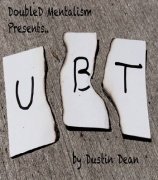 I've posted a review of UBT on another site, but I like it so much that I am going to tell you here that if you are new to mentalism and don't have a good billet peek, or you are not comfortable with the one that you are using, then you must give this a try. Once you work on it--and it's not that hard to do--you'll use it forever. As I said in my other review, it is a tear of the "instant/real-time peek" variety, unlike a traditional center tear. Bob Cassidy would question why one would use a technique where you take the peek when the audience is burning your hands as you rip up the billet instead of being more traditional and taking the peek on an offbeat or after a logical disconnect. That you have to answer for yourself. Whatever accomplishes the result deceptively is what you should use.
I've posted a review of UBT on another site, but I like it so much that I am going to tell you here that if you are new to mentalism and don't have a good billet peek, or you are not comfortable with the one that you are using, then you must give this a try. Once you work on it--and it's not that hard to do--you'll use it forever. As I said in my other review, it is a tear of the "instant/real-time peek" variety, unlike a traditional center tear. Bob Cassidy would question why one would use a technique where you take the peek when the audience is burning your hands as you rip up the billet instead of being more traditional and taking the peek on an offbeat or after a logical disconnect. That you have to answer for yourself. Whatever accomplishes the result deceptively is what you should use.
If you use another peek such as a classic center tear, Osterlind's Perfected Center Tear, etc., and it serves you well, you might not need this. Then again, for me, this is a real thing of beauty. It's quick, clean, and straightforward. Highest recommendation.
Ekcentrick Force
Overall customer rating: ★★★★★reviewed by Christian Fisanick (confirmed purchase)
Rating: ★★★★★ (Date Added: Tuesday 13 September, 2016)
 This is a short and direct way to force any one of six coins or other objects by a selection/elimination process. It takes a little bit of thought and practice, but it's good and certainly much better than the artificial looking "hot rod" force which involves counting or spelling. Add it to your arsenal of forces such as equivoque, PATEO, Quinta, and psi forces. It's a worker.
This is a short and direct way to force any one of six coins or other objects by a selection/elimination process. It takes a little bit of thought and practice, but it's good and certainly much better than the artificial looking "hot rod" force which involves counting or spelling. Add it to your arsenal of forces such as equivoque, PATEO, Quinta, and psi forces. It's a worker.
Number 5
Overall customer rating: ★★★★★reviewed by Christian Fisanick (confirmed purchase)
Rating: ★★★★★ (Date Added: Sunday 14 August, 2016)
 While Number 5 may look simplistic when cut down to the actual method of the effect, but when coupled with a good presentation, you'll have a powerful routine of Tarot reading or numerology--and an excellent prediction To say more would be to ruin the surprise of reading this wonderful ebook. I would ordinarily say that it's going right in my wallet for the impromptu act, but you don't need to prepare anything so you don't even need the wallet. (I think that I will alternate this with Lee Earle's Life Force, another self-worker that gives you great latitude to do a numerology reading.) All you need are two business cards or two slips of paper and a pen. How's that for nearly propless imromptu mentalism? This is clearly a professional routine devised by a professional. Amateurs won't spend the time to get the presentation down and will just jump right to the prediction. That would be a shame because as a previous reviewer said, the power of Number 5 is that it's about the reading and then the great prediction, which doesn't seem tacked on at all. For impromptu mentalism, you can't beat this highly recommended routine.
While Number 5 may look simplistic when cut down to the actual method of the effect, but when coupled with a good presentation, you'll have a powerful routine of Tarot reading or numerology--and an excellent prediction To say more would be to ruin the surprise of reading this wonderful ebook. I would ordinarily say that it's going right in my wallet for the impromptu act, but you don't need to prepare anything so you don't even need the wallet. (I think that I will alternate this with Lee Earle's Life Force, another self-worker that gives you great latitude to do a numerology reading.) All you need are two business cards or two slips of paper and a pen. How's that for nearly propless imromptu mentalism? This is clearly a professional routine devised by a professional. Amateurs won't spend the time to get the presentation down and will just jump right to the prediction. That would be a shame because as a previous reviewer said, the power of Number 5 is that it's about the reading and then the great prediction, which doesn't seem tacked on at all. For impromptu mentalism, you can't beat this highly recommended routine.
Silent Words
Overall customer rating: ★★★★★reviewed by Christian Fisanick (confirmed purchase)
Rating: ★★★★★ (Date Added: Sunday 14 August, 2016)
 This is a mentalism routine that you can do in two, three, or four parts. It's extremely smart, baffling, and versatile. In the first phase, an advanced version of a prodigal principle is used, or as the Unknown Mentalist puts it, it's done in a "turbo" way. That it is. Applause. Well done! This principle by itself is worth the price of the ebook. The second phase uses an old-school counting principle that I personally don't like. I will most likely use a sleight here--or you could a Scott Creasey-style gimmicked envelope or even a variation on Reg Blackwood's X-Way Pad--but it's up to you. This is all quite flexible, depending on how you want to do this. The optional third phase uses one of my favorite cool items that wasn't manufactured with magic in mind, but it's perfect for magicians and mentalists. And the optional "encore" phase is the fundamental or un-turbo handling of phase one. This really is a terrific routine, whether you do it the whole way through or only in a shortened version. While it's not complicated as these types of processes go, you will need a little bit of memory work and practice. Otherwise, you've have close-up mentalism at its finest. Highly recommended.
This is a mentalism routine that you can do in two, three, or four parts. It's extremely smart, baffling, and versatile. In the first phase, an advanced version of a prodigal principle is used, or as the Unknown Mentalist puts it, it's done in a "turbo" way. That it is. Applause. Well done! This principle by itself is worth the price of the ebook. The second phase uses an old-school counting principle that I personally don't like. I will most likely use a sleight here--or you could a Scott Creasey-style gimmicked envelope or even a variation on Reg Blackwood's X-Way Pad--but it's up to you. This is all quite flexible, depending on how you want to do this. The optional third phase uses one of my favorite cool items that wasn't manufactured with magic in mind, but it's perfect for magicians and mentalists. And the optional "encore" phase is the fundamental or un-turbo handling of phase one. This really is a terrific routine, whether you do it the whole way through or only in a shortened version. While it's not complicated as these types of processes go, you will need a little bit of memory work and practice. Otherwise, you've have close-up mentalism at its finest. Highly recommended.
DIY I-Pad: Do It Yourself Impression Pad
Overall customer rating: ★★★★★reviewed by Christian Fisanick (confirmed purchase)
Rating: ★★★★★ (Date Added: Monday 01 August, 2016)
 Excellent, excellent, excellent. That's all I really need to say about Scott Creasey's video instructions for making your own imp pad. All you need to do is get a bunch of cheap pads and a three-piece set of one special thing that you can buy on Amazon for about $12.50, but it's enough to make you at least a half-dozen DIY I-Pads. I currently use Mark Elsdon's commercially manufactured Spy Pad, which is very similar in concept. It costs $40, as I recall, and while refills are about half that, you have to use a refill after about 50 uses. With Scott's DIY I-Pad, once you buy your special thing pack for $12.50, you are pretty much set for years. All you have to do is buy up some cheap pads that cost a couple of bucks at OfficeMax. As soon as my Amazon order arrives and I use up my current Spy Pad, I'm a convert. This is the best impression device for the money.
Excellent, excellent, excellent. That's all I really need to say about Scott Creasey's video instructions for making your own imp pad. All you need to do is get a bunch of cheap pads and a three-piece set of one special thing that you can buy on Amazon for about $12.50, but it's enough to make you at least a half-dozen DIY I-Pads. I currently use Mark Elsdon's commercially manufactured Spy Pad, which is very similar in concept. It costs $40, as I recall, and while refills are about half that, you have to use a refill after about 50 uses. With Scott's DIY I-Pad, once you buy your special thing pack for $12.50, you are pretty much set for years. All you have to do is buy up some cheap pads that cost a couple of bucks at OfficeMax. As soon as my Amazon order arrives and I use up my current Spy Pad, I'm a convert. This is the best impression device for the money.
The Single White Dwarf
Overall customer rating: ★★★★★reviewed by Christian Fisanick (confirmed purchase)
Rating: ★★★★★ (Date Added: Monday 01 August, 2016)
 Scott Creasey outdoes himself with the latest of his DIY gimmicked-envelope videos. If you have any of Scott's other ebooks and videos from lybrary, you already know that he (1) really knows his stuff; (2) has brilliantly creative ideas for gimmicked envelopes; and (3) produces excellent instructional videos with good production values. Expanding upon and refining a Bob Cassidy envelope concept, he shows you how to make--in about five minutes--a peek envelope. We're not talking window envelope, Shaxon envelope, or one using a tricky impression gimmick. It's a single opaque mailing envelope, plain and simple. And it's exceedingly clean and clever. In addition to the construction instructions--easy enough for a pre-schooler with round-nosed scissors and a glue stick to follow--he gives you three routines. Two are classic Cassidy routines--Name and Place and 4th Dimensional Telepathy--that once you see how the envelope works, you'll wonder why you've been doing the original versions with all the "moves" and "subtleties" all these years. Switch to the Single White Dwarf envelope, and you don't have to do much of anything to accomplish these mental miracles. The third is Scott's own routine which makes the spectator the psychic. If you build up the patter as he does, it's a cute and mysterious routine I like it.
Scott Creasey outdoes himself with the latest of his DIY gimmicked-envelope videos. If you have any of Scott's other ebooks and videos from lybrary, you already know that he (1) really knows his stuff; (2) has brilliantly creative ideas for gimmicked envelopes; and (3) produces excellent instructional videos with good production values. Expanding upon and refining a Bob Cassidy envelope concept, he shows you how to make--in about five minutes--a peek envelope. We're not talking window envelope, Shaxon envelope, or one using a tricky impression gimmick. It's a single opaque mailing envelope, plain and simple. And it's exceedingly clean and clever. In addition to the construction instructions--easy enough for a pre-schooler with round-nosed scissors and a glue stick to follow--he gives you three routines. Two are classic Cassidy routines--Name and Place and 4th Dimensional Telepathy--that once you see how the envelope works, you'll wonder why you've been doing the original versions with all the "moves" and "subtleties" all these years. Switch to the Single White Dwarf envelope, and you don't have to do much of anything to accomplish these mental miracles. The third is Scott's own routine which makes the spectator the psychic. If you build up the patter as he does, it's a cute and mysterious routine I like it.
Now truth be told, I know of an even lazier version of a Single White Dwarf envelope that takes no construction whatsoever, but let's just say it's a little touchy and not as clean. Scott's envelope, while ever-so-slightly more complicated, is better. Once you see how it works, you'll go, "Of course it logically works that way. Why didn't I come up with that? That's terrific!" This is highly recommended because you are going to want a few of these in your mentalism bag at all times. They are worth their weight in gold.
Ostrakinda
Overall customer rating: ★★★★★reviewed by Christian Fisanick (confirmed purchase)
Rating: ★★★★★ (Date Added: Wednesday 27 July, 2016)
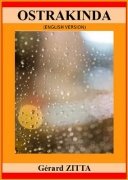 "Which hand" routines are popular these days. Even the great Derren Brown does a which-hand performance Probably the best known--at least best selling--version is Mark Elsdon's Tequila Hustler. One way of doing which hand is heavily process driven, and Elsdon seems to have come up with an excellent way of hiding the process so that it doesn't look like something that you'd easily suspect. Ostrakinda really is Elsdon's approach as applied to Max Maven's positive/negative. In other words, you use Elsdon's process to determine whether the coin is heads or tails.
"Which hand" routines are popular these days. Even the great Derren Brown does a which-hand performance Probably the best known--at least best selling--version is Mark Elsdon's Tequila Hustler. One way of doing which hand is heavily process driven, and Elsdon seems to have come up with an excellent way of hiding the process so that it doesn't look like something that you'd easily suspect. Ostrakinda really is Elsdon's approach as applied to Max Maven's positive/negative. In other words, you use Elsdon's process to determine whether the coin is heads or tails.
Being sort of an afficiando of all these which hand and positive/negative routines, I knew almost immediately that this is basically nothing more than substituting some verbiage in Elsdon's routine. But admittedly, I didn't think of it first, and it works perfectly. Is it worth $12 instead of Tequila Huster? (It is indeed less expensive.) Probably not. I think this might have been better as a variant included at the end of the Tequila Hustler book. If you don't have Tequilla Hustler, buy that ebook because it has a lot of theory, variants, and performance tips for this type of process. If you do have Tequilla Hustler and want to apply it to positive/negative, then Ostrakinda will do the trick. But after you read it, you'll probably agree with me that this would have been better as a variant rather than a stand-alone effect.
Why A Magic Square Should Not Be A Magic Square
Overall customer rating: ★★★★★reviewed by Christian Fisanick (confirmed purchase)
Rating: ★★★★★ (Date Added: Wednesday 27 July, 2016)
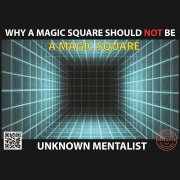 The Unknown Mentalist gives some excellent, practical advice on how to camouflage a magic square so that it doesn't look like a magic square or the dreaded mathe-magic. It's all in the presentation, of course, and he supplies you with a really good, straightforward, pure magic square routine that looks simply like adding random numbers, not necessarily selected as numbers. (Get the ebook, and you'll find out what I mean.)
The Unknown Mentalist gives some excellent, practical advice on how to camouflage a magic square so that it doesn't look like a magic square or the dreaded mathe-magic. It's all in the presentation, of course, and he supplies you with a really good, straightforward, pure magic square routine that looks simply like adding random numbers, not necessarily selected as numbers. (Get the ebook, and you'll find out what I mean.)
Audiences are more sophisticated these days, and what was once astonishing in the gas-light era is just ho-hum in the Internet age. It's nice to read this thoughtful ebook. We need more writing like this to help us tweak classic performance tools for the 21st Century. I'm sure Martin Gardner would have been proud.
Winnebago: an experiment in remote viewing
Overall customer rating: ★★★★★reviewed by Christian Fisanick (confirmed purchase)
Rating: ★★★★★ (Date Added: Tuesday 12 July, 2016)
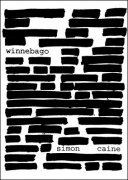 Winnebago is essentially "Calling the Cards"--or in this case, card--with the twist of having the spectator as mentalist. (Watch Richard Osterlind's version of Calling the Cards on a few of his DVDs with the spectator's having three cards in his pocket. It is fantastic.) The routine, played as remote viewing, is OK; it will definitely work if you have a standard mentalism technique down cold; and although I haven't performed it yet, I am fairly certain that I could get a nice reaction out of it. But it's just not worth $15, more like $8 or $5--or maybe even less as one of nine effects in a version of Mark Elsdon's classic Conversation as Mentalism booklets that go for $30 each. Anyway, I hate to be negative to sincere, hardworking mentalists who put out material, but my rating reflects a good effect that is way overpriced.
Winnebago is essentially "Calling the Cards"--or in this case, card--with the twist of having the spectator as mentalist. (Watch Richard Osterlind's version of Calling the Cards on a few of his DVDs with the spectator's having three cards in his pocket. It is fantastic.) The routine, played as remote viewing, is OK; it will definitely work if you have a standard mentalism technique down cold; and although I haven't performed it yet, I am fairly certain that I could get a nice reaction out of it. But it's just not worth $15, more like $8 or $5--or maybe even less as one of nine effects in a version of Mark Elsdon's classic Conversation as Mentalism booklets that go for $30 each. Anyway, I hate to be negative to sincere, hardworking mentalists who put out material, but my rating reflects a good effect that is way overpriced.
Just Think
Overall customer rating: ★★★★★reviewed by Christian Fisanick (confirmed purchase)
Rating: ★★★★★ (Date Added: Sunday 10 July, 2016)
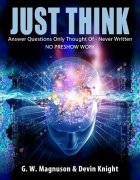 This one goes way back. I got Just Think because I was curious. I had an idea of how it worked--and I was right. And for those of you who get this, you will immediately note that this effect uses the same principle as a famous item that has been on the market since the 1950s, though this version is 100% pure and uses no gimmicks whatsoever. I like Devin's use of this effect as after-show individual future telling and also his performance hints. I don't think that you can effectively use it for a main act unless, of course, you are a real fortune teller because to quote Rick Maue, "TERASABOS." Pros will know what I mean and could make some use of this. Mentalism neophytes, despite your skepticism, this kind of stuff really does work. But it takes chutzpah, audience management, personality, and experience.
This one goes way back. I got Just Think because I was curious. I had an idea of how it worked--and I was right. And for those of you who get this, you will immediately note that this effect uses the same principle as a famous item that has been on the market since the 1950s, though this version is 100% pure and uses no gimmicks whatsoever. I like Devin's use of this effect as after-show individual future telling and also his performance hints. I don't think that you can effectively use it for a main act unless, of course, you are a real fortune teller because to quote Rick Maue, "TERASABOS." Pros will know what I mean and could make some use of this. Mentalism neophytes, despite your skepticism, this kind of stuff really does work. But it takes chutzpah, audience management, personality, and experience.
The Unswami
Overall customer rating: ★★★★★reviewed by Christian Fisanick (confirmed purchase)
Rating: ★★★★★ (Date Added: Wednesday 22 June, 2016)
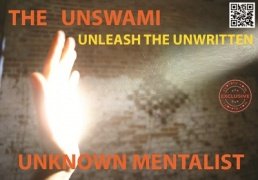 Recipe for mentalism ebook success: take one forgotten tool out of mothballs, explain its uses comprehensively well, add some nice routines, and add a few variations on those nice routines. Voila! Great ebook, an essential primer really for this gimmick. The unswami or stylus writer--no, I'm not giving things away here since it's already been mentioned in one of the headliner reviews--was completely forgotten by most...until now. (It's mentioned in Corinda, but then again, so many people don't want to read Corinda because "it's outdated." Right. Keep up that thinking. The Unknown Mentalist and I will run rings around your mentalism with all the "out-dated" stuff that we read in Corinda.) I can't hype this book enough. If you use a swami gimmick--and even if you have Corinda memorized and are familiar with how this all works--you'll need this package set. Your swami may be weapon #1 and the unswami #2 or vice versa. Both have their pros and cons but can be equally effective. Now not everyone uses or even likes swamis. They take practice and a large amount of absolute confidence in presentation. If you are a swami-addict, however, then take the plunge and go in--or "un"--on the unswami.
Recipe for mentalism ebook success: take one forgotten tool out of mothballs, explain its uses comprehensively well, add some nice routines, and add a few variations on those nice routines. Voila! Great ebook, an essential primer really for this gimmick. The unswami or stylus writer--no, I'm not giving things away here since it's already been mentioned in one of the headliner reviews--was completely forgotten by most...until now. (It's mentioned in Corinda, but then again, so many people don't want to read Corinda because "it's outdated." Right. Keep up that thinking. The Unknown Mentalist and I will run rings around your mentalism with all the "out-dated" stuff that we read in Corinda.) I can't hype this book enough. If you use a swami gimmick--and even if you have Corinda memorized and are familiar with how this all works--you'll need this package set. Your swami may be weapon #1 and the unswami #2 or vice versa. Both have their pros and cons but can be equally effective. Now not everyone uses or even likes swamis. They take practice and a large amount of absolute confidence in presentation. If you are a swami-addict, however, then take the plunge and go in--or "un"--on the unswami.
Julio's Psychic Pizza Menu
Overall customer rating: ★★★★★reviewed by Christian Fisanick (confirmed purchase)
Rating: ★★★★★ (Date Added: Wednesday 22 June, 2016)
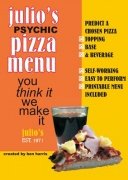 Here's a new trick from the prolific Ben Harris, where you, the mentalist, successfully predict the type of pizza and accompanying beverage the spectator will choose. You get simple instructions and some nice graphics to create your own full-color "menu" using your own color printer. The effect is nearly self-working. You merely have to remember one easy principle; the menu then does all the work for you.
Here's a new trick from the prolific Ben Harris, where you, the mentalist, successfully predict the type of pizza and accompanying beverage the spectator will choose. You get simple instructions and some nice graphics to create your own full-color "menu" using your own color printer. The effect is nearly self-working. You merely have to remember one easy principle; the menu then does all the work for you.
This is a cute trick. As a theme, everyone likes pizza, and the thought of "Wouldn't it be great if you could just think of the kind of pizza and drink that you wanted?" will make you smile. As for the working, there's nothing new here: It's Phill Smith's Quinta-like "counting" plus Bill Goldman's Mental Yarn "principle," the latter making the trick clever after the much weaker initial process.
As I'm fond of saying, "This is no world-beater." It's one of those in-betweener routines for the middle of a show, bordering on an effect you toss-off for your friends. But I use the thought of pizza in a much different routine, so this could work as a nice follow-up to that one. For $8, you can't go wrong with the instant download, though it would be nice for the money if you got the pre-made, laminated menu. Overall, it's a polite "golf clap" to Julio's Psychic Pizza Menu, rather than a full-blown standing ovation.
Flip and Tell
Overall customer rating: ★★★★★reviewed by Christian Fisanick (confirmed purchase)
Rating: ★★★★★ (Date Added: Thursday 16 June, 2016)
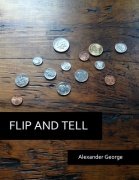 Flip and Tell uses a 50-year-old Martin Gardner principle dressed up in a new routine. If you watch the video, you'll see exactly how it plays out, and if impromptu effects are to your liking, you'll like this. It reminds me of something that you'd see in one of Mark Elsdon's Conversations as Mentalism books (He's up to four now. Get them all because they're great.) in that you can do it anywhere on the spur of the moment with just a bunch of coins, a wallet, and a flat surface. By itself, it's not an effect that will get you your own BBC mentalism series, but as a supplement to a "which hand" or positive/negative routine, it's nice and quite baffling. I followed the instructions, turned coins over, and BAM! It works great. There is one small move, and if you watch the video a few times, you probably can figure out the essence of what it is, but when you do it once for a spectator, it will fly by without much thought. And the price is around you'd pay for a single trick out of one of Elsdon's "CAM" books. In other words, here you have a slick, inexpensive impromptu effect. It's one of many different propless or nearly propless things that I can do. Recommended.
Flip and Tell uses a 50-year-old Martin Gardner principle dressed up in a new routine. If you watch the video, you'll see exactly how it plays out, and if impromptu effects are to your liking, you'll like this. It reminds me of something that you'd see in one of Mark Elsdon's Conversations as Mentalism books (He's up to four now. Get them all because they're great.) in that you can do it anywhere on the spur of the moment with just a bunch of coins, a wallet, and a flat surface. By itself, it's not an effect that will get you your own BBC mentalism series, but as a supplement to a "which hand" or positive/negative routine, it's nice and quite baffling. I followed the instructions, turned coins over, and BAM! It works great. There is one small move, and if you watch the video a few times, you probably can figure out the essence of what it is, but when you do it once for a spectator, it will fly by without much thought. And the price is around you'd pay for a single trick out of one of Elsdon's "CAM" books. In other words, here you have a slick, inexpensive impromptu effect. It's one of many different propless or nearly propless things that I can do. Recommended.
Rush: Close-Up Russian Roulette
Overall customer rating: ★★★★★reviewed by Christian Fisanick (confirmed purchase)
Rating: ★★★★★ (Date Added: Thursday 16 June, 2016)
 For a while there, it seemed that every magician that you saw on TV did the death defying Russian Roulette feat with the nailguns or the spike under the paper bags. Dee Christopher, among others, has downsized the effect for close-up performance using Bic lighters. It's a pretty good trick, and perhaps slightly more dangerous looking than Cobra Kiss, which uses the mini-staplers, but I have to ask, to what end? The big-brother stage versions have been so overused that they have lost their novelty so the miniturized versions, which are much less dangerous, are even more muted in effect.
For a while there, it seemed that every magician that you saw on TV did the death defying Russian Roulette feat with the nailguns or the spike under the paper bags. Dee Christopher, among others, has downsized the effect for close-up performance using Bic lighters. It's a pretty good trick, and perhaps slightly more dangerous looking than Cobra Kiss, which uses the mini-staplers, but I have to ask, to what end? The big-brother stage versions have been so overused that they have lost their novelty so the miniturized versions, which are much less dangerous, are even more muted in effect.
The instructions here are good, and you'll need a bunch of a specific type of disposable lighter that you will need to modify. The fabrication of the effect is fairly easy. Pulling it off effectively is somewhat harder because there is a move involved that you have to execute multiple times, which I personally think is fishy. (The best way to do it is probably misdirect your spectator to examine another lighter in a kind of "one-behind" way.) For what this effect is, it's clever, and it does work as promised. For me, I prefer a completely non-dangerous version by Titanas using shaken-up soda cans. The worst that the audience thinks could happen is that a can explodes, and I get soaked (just like in the old SCTV Doug & Bob McKenzie bit called "The Beer Hunter"). While that routine removes the danger element, it's much more devious and easier to do. I'm not really sold on Rush with the lighters, but you may prefer it.
The Impromptu Mystifier
Overall customer rating: ★★★★★reviewed by Christian Fisanick (confirmed purchase)
Rating: ★★★★★ (Date Added: Thursday 16 June, 2016)
 Kennedy is one of the best up-and-coming UK mentalists. This book, his first, is loaded with sage wisdom about using off-the-cuff performances to build your reputation and get jobs. Ken speaks from experience, and his essays are spot-on. He then outlines his impromptu routine, which--if memory serves me--has five effects. They are all at least good, a couple are excellent, and one, his Window of Opportunity peek, I think is fantastic. I always keep a few of the specially folded business cards with me to do it and have, in fact, expanded his original presentation. While it's a tad more complicated than Acidus Novus, the Corinda peek, or that cool billet opening thing that Richard Osterlind has demonstrated on a couple of his DVDs, a few days of practice idly doing the move with my left hand was more than enough time to get pretty good at it. It's a worker.
Kennedy is one of the best up-and-coming UK mentalists. This book, his first, is loaded with sage wisdom about using off-the-cuff performances to build your reputation and get jobs. Ken speaks from experience, and his essays are spot-on. He then outlines his impromptu routine, which--if memory serves me--has five effects. They are all at least good, a couple are excellent, and one, his Window of Opportunity peek, I think is fantastic. I always keep a few of the specially folded business cards with me to do it and have, in fact, expanded his original presentation. While it's a tad more complicated than Acidus Novus, the Corinda peek, or that cool billet opening thing that Richard Osterlind has demonstrated on a couple of his DVDs, a few days of practice idly doing the move with my left hand was more than enough time to get pretty good at it. It's a worker.
I'm fairly sure that the title The Impromtu Mystifier is a tip of the hat to the great Bob Cassidy and his The Impromptu Psychic. While that work may have more routines, I think that this book is the better value for its outstanding advice on mentalism in general--and that great peek.
Messing with NCR Paper
Overall customer rating: ★★★★★reviewed by Christian Fisanick (confirmed purchase)
Rating: ★★★★★ (Date Added: Thursday 16 June, 2016)
 Anyone who has seen a few episodes of the classic TV series Mystery Science Theater 3000 is probably familiar with the tag "...at first." It's a brilliant way of commenting on something that initially appears to be good or encouraging but on reflection is not, as in "Charles Manson looked like a quiet, unassuming guy...at first." That's kind of how I feel about Messing with NCR Paper. I'd heard about the book, tracked it down, read it, and was excited...at first. It even begins with a thrilling fax between experts that sounded like Fermat's Last Equation had finally been solved. But alas, reading the book, I learned something that I and many others already knew, that NCR paper could substitute for carbon paper, and one more thing that I didn't know, the properties of using a fluorescent highlighter with NCR paper. That latter principle, while interesting, has limited utility. The author entreats folks to do further research in this area, but nothing came of it that I am aware of. It's interesting but a dead end. But messing with NCR Paper did have my attention...at first.
Anyone who has seen a few episodes of the classic TV series Mystery Science Theater 3000 is probably familiar with the tag "...at first." It's a brilliant way of commenting on something that initially appears to be good or encouraging but on reflection is not, as in "Charles Manson looked like a quiet, unassuming guy...at first." That's kind of how I feel about Messing with NCR Paper. I'd heard about the book, tracked it down, read it, and was excited...at first. It even begins with a thrilling fax between experts that sounded like Fermat's Last Equation had finally been solved. But alas, reading the book, I learned something that I and many others already knew, that NCR paper could substitute for carbon paper, and one more thing that I didn't know, the properties of using a fluorescent highlighter with NCR paper. That latter principle, while interesting, has limited utility. The author entreats folks to do further research in this area, but nothing came of it that I am aware of. It's interesting but a dead end. But messing with NCR Paper did have my attention...at first.
Forces, Peeks, Stacks and Gaffs
Overall customer rating: ★★★★★reviewed by Christian Fisanick (confirmed purchase)
Rating: ★★★★★ (Date Added: Thursday 16 June, 2016)
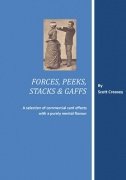 Here's another ebook from the amazingly prolific Mr. Creasey. It shows you some non-knuckle-busting sleights that you can apply to mentalism. I like books like this because they allow you to expand your horizons and, as I've mentioned about Scott before, "think outside the box." He has put together a useful collection of sleights and gaffs and routines using them. While this book doesn't fall into the category of "essential," I would rate it as "nice to have." For example, a peek explained here is similar to a one that I learned as a teenager back in 1974 when I first read it in The Amateur Magician's Handbook by Henry Hay. (Here's another review of mine with a familiar refrain: Buy that book, Bob Cassidy's favorite too. Nuff said!) I've lost track of how many times that I've used it, and I've always gotten away with it. Never been burned. Not once. And it's not that I'm an A-student sleight-of-hand worker. Trust me, I'm not. It's just one of those sleights that on paper looks like absolute garbage--fishy deck handling with lots of heat when the peek is taken--until you try it. And to be honest, as a kid, I didn't really pay much attention to nuances like doing things on the offbeat. But it didn't matter. It worked. It always worked so I just stuck with it. I realize that everybody's different and things are all subjective. What works for you might not work for me. What works for me might make you think that I'm an idiot. That's OK too. But more mentalists need to realize that something that sounds stupid--like using a weird card peek--or looks bad on paper might just be what you need. Or as the Rolling Stones said, "You can't always get what you want. But if you try sometimes, well, you might find you get what you need." You need to experiment and find your own path. Scott's good little book is a first step.
Here's another ebook from the amazingly prolific Mr. Creasey. It shows you some non-knuckle-busting sleights that you can apply to mentalism. I like books like this because they allow you to expand your horizons and, as I've mentioned about Scott before, "think outside the box." He has put together a useful collection of sleights and gaffs and routines using them. While this book doesn't fall into the category of "essential," I would rate it as "nice to have." For example, a peek explained here is similar to a one that I learned as a teenager back in 1974 when I first read it in The Amateur Magician's Handbook by Henry Hay. (Here's another review of mine with a familiar refrain: Buy that book, Bob Cassidy's favorite too. Nuff said!) I've lost track of how many times that I've used it, and I've always gotten away with it. Never been burned. Not once. And it's not that I'm an A-student sleight-of-hand worker. Trust me, I'm not. It's just one of those sleights that on paper looks like absolute garbage--fishy deck handling with lots of heat when the peek is taken--until you try it. And to be honest, as a kid, I didn't really pay much attention to nuances like doing things on the offbeat. But it didn't matter. It worked. It always worked so I just stuck with it. I realize that everybody's different and things are all subjective. What works for you might not work for me. What works for me might make you think that I'm an idiot. That's OK too. But more mentalists need to realize that something that sounds stupid--like using a weird card peek--or looks bad on paper might just be what you need. Or as the Rolling Stones said, "You can't always get what you want. But if you try sometimes, well, you might find you get what you need." You need to experiment and find your own path. Scott's good little book is a first step.
UNO-IT
Overall customer rating: ★★★★★reviewed by Christian Fisanick (confirmed purchase)
Rating: ★★★★★ (Date Added: Thursday 16 June, 2016)
 Scott Creasey, while perhaps not as well known as some of the other UK mentalists, is a real hero of mine. To put it simply, he rocks. He has so many good DIY projects, books, tricks, and routines that I have no hesitation in using overused words like "brilliant" and "genius" because he really is. Here's a prime example: a multi-part routine of nice duration using, of all things, Uno cards. I love it. Everyone has seen Uno cards. They have numbers and pretty colors. For folks who want to engage in the silly, pointless discussion about whether mentalists should use cards, how about using Uno cards? They are common the world over and don't shout, "Not mentalism, card trick!" This is great outside-the-box thinking by Scott.
Scott Creasey, while perhaps not as well known as some of the other UK mentalists, is a real hero of mine. To put it simply, he rocks. He has so many good DIY projects, books, tricks, and routines that I have no hesitation in using overused words like "brilliant" and "genius" because he really is. Here's a prime example: a multi-part routine of nice duration using, of all things, Uno cards. I love it. Everyone has seen Uno cards. They have numbers and pretty colors. For folks who want to engage in the silly, pointless discussion about whether mentalists should use cards, how about using Uno cards? They are common the world over and don't shout, "Not mentalism, card trick!" This is great outside-the-box thinking by Scott.
Scott gives you a three-part routine and some bonuses. I am not a fan of doing multi-part routines copied chapter-and-verse from another mentalist--I want to be my own performer--but the parts here are easily divisible and independent, and you can mix and match. There isn't anything new in the methodology, but these are excellent effects. Some books are so sparsely written that it's hard to grasp what kind of presentation the effect needs, while others are so overwritten--with every supposedly hilarious one-liner and snide remark--that you have to separate the good from the bad. In all of Scott's routining, he strikes a nice balance: enough on presentation and nothing overdone. He's a fine writer.
One more thing for educational purposes--and I'm not giving away trade secrets because without the context of Uno-It, this will be cryptic, but I want to encourage you to check it out. As I said, there's nothing new in the methodology here. Perhaps, more correctly, I should say that in one aspect, the methodology relies on something so old and obscure that even some card guys may not be fully aware of it, the corner short. Richard Osterlind is a big proponent, and the Uno-It routine uses it effectively too. Until you play around with it and see that it can also save you in an emergency, you may not realize that it's something good to know about if you handle card decks. Get out your copy of Hugard and Braue in addition to purchasing Uno-It and check it out. You won't be disappointed. You might even be enlightened.
The Mati Envelope
Overall customer rating: ★★★★★reviewed by Christian Fisanick (confirmed purchase)
Rating: ★★★★★ (Date Added: Wednesday 15 June, 2016)
 Throughout mentalism history, there have been a lot of different gimmicked envelopes--slit, window, Shaxon, impression, etc.--all designed to secretly learn what the spectator has written. Obviously, this comes in handy in not only direct mind reading routines, but also design duplications, Q&A's, and more elaborate routines such as Cassidy's 4th Dimensional Telepathy and Name and Place. Imagine if you will, an envelope that allows you to learn the information while the envelope, which is normal looking (in the interest of full disclosure, "looking" is the operative word here, friends), remains in the spectator's hand. With his writing inside. Sealed. And you can get your peek of the information in the next room. And unless the spectator knows exactly what to look for, he's going to be able to look at the envelope and see nothing. How is that possible, you ask. Well, I'm dying to tell you about the Mati Envelope, but Jiminy Cricket says let your conscience be your guide so I can't. And even if I did, this review would get edited. So this secret--and oh my, it's a good one--comes at a price, a really reasonable one, I think.
Throughout mentalism history, there have been a lot of different gimmicked envelopes--slit, window, Shaxon, impression, etc.--all designed to secretly learn what the spectator has written. Obviously, this comes in handy in not only direct mind reading routines, but also design duplications, Q&A's, and more elaborate routines such as Cassidy's 4th Dimensional Telepathy and Name and Place. Imagine if you will, an envelope that allows you to learn the information while the envelope, which is normal looking (in the interest of full disclosure, "looking" is the operative word here, friends), remains in the spectator's hand. With his writing inside. Sealed. And you can get your peek of the information in the next room. And unless the spectator knows exactly what to look for, he's going to be able to look at the envelope and see nothing. How is that possible, you ask. Well, I'm dying to tell you about the Mati Envelope, but Jiminy Cricket says let your conscience be your guide so I can't. And even if I did, this review would get edited. So this secret--and oh my, it's a good one--comes at a price, a really reasonable one, I think.
So what can I say about this thing? Well, it combines an underground technique from about 40 years ago that has recently resurfaced with a classic bit of envelope handling. That handling, unless you have cloven hooves for hands, is pretty easy. So if you can use a stack of Shaxon flapless envelopes, you can do this. [Note: Part of the working uses the same principle as the commercially manufactured effect, Steam 2.0. But while that method is brilliant, I think that the Steam effect has a flaw that spoils its effectiveness, at least in the standard handling. If you go on Penguin Magic's website and watch the trailer, that part of the trick is edited out--which should tell you something. With the Mati Envelope, this flaw is completely eliminated.]
How hard is it to make? It's not complicated at all, but you'll need to get some supplies at your office supply store and most likely order one essential item from Amazon. Don't fret. It's not something weird that's going to scream "gimmick." It's an ordinary object on the outside with a different composition than usual on the inside. It will pass completely undetected as ordinary. The comprehensive ebook gives good instructions, and it doesn't take long, but truth be told, I had to stop and reorient my thinking to get back on the right track. But once I did that, I quickly made up a stack of about a dozen envelopes.
When all is done, you will have a utility envelope that is far beyond anything that you've seen. Looking over comments on the various magic websites, I'm struck by how little commentary there is about the Mati Envelope. This thing is revolutionary actually, and I would have thought that more people would be raving about it. But they aren't (maybe it's the fear of the unknown or the DIY aspect)--which is good for those of us who get it and use it. I see a lot of things, many of which are excellent and useful, but this is at the highest echelon of the gimmicked envelope field. Now some are going to say that they use a slit/window/Shaxon/impression envelope, and it works just fine. My response is "great," whatever works for you. Maybe you don't need an envelope that--unless someone scrutinizes it super closely before it is finally torn open--allows you to end totally clean, something that you can't do with the others. But this innovation is so devious and seductive, it would be hard to turn away from it once you read about it. It's that good.
Excalibur Forcing Deck
Overall customer rating: ★★★★★reviewed by Christian Fisanick (confirmed purchase)
Rating: ★★★★★ (Date Added: Wednesday 15 June, 2016)
 As a mentalist and not a card guy anymore, I'm always amused by the way some current world-class mentalist will take a hoary gimmicked deck out of mothballs and use it to great effect. The card guys just roll their eyes and think things like, "Tut. Tut. Look at the mentalist, such a simple soul, he's using a gimmicked deck from the 1940s to force a card. Awww, that's so cute. We cardicians know 50 different ways to force a card using Marlo/Vernon sleights that only took steady daily practice over a decade to master." Perhaps I exaggerate, but while sleights are great and pure, I love the way you can take something simple and easy and be just as effective. Luke Jermay uses a Franklin Taylor peek deck. Richard Osterland, much earlier in his career, came up with the Radar and Dynamo decks, variations on the Bagshawe/Koran deck, before abandoning them in favor of his Breakthrough Card System. And if I recall correctly, Derren Brown wowed a TV producer with a Mind Power deck. There's no shame in using a gimmicked deck if you are a professional and know what you are doing. If you are an amateur, there's nothing to see here. Go back to working on your classical force until it's perfect.
As a mentalist and not a card guy anymore, I'm always amused by the way some current world-class mentalist will take a hoary gimmicked deck out of mothballs and use it to great effect. The card guys just roll their eyes and think things like, "Tut. Tut. Look at the mentalist, such a simple soul, he's using a gimmicked deck from the 1940s to force a card. Awww, that's so cute. We cardicians know 50 different ways to force a card using Marlo/Vernon sleights that only took steady daily practice over a decade to master." Perhaps I exaggerate, but while sleights are great and pure, I love the way you can take something simple and easy and be just as effective. Luke Jermay uses a Franklin Taylor peek deck. Richard Osterland, much earlier in his career, came up with the Radar and Dynamo decks, variations on the Bagshawe/Koran deck, before abandoning them in favor of his Breakthrough Card System. And if I recall correctly, Derren Brown wowed a TV producer with a Mind Power deck. There's no shame in using a gimmicked deck if you are a professional and know what you are doing. If you are an amateur, there's nothing to see here. Go back to working on your classical force until it's perfect.
When I first looked at Knight's Exacalibur Forcing Deck, I wasn't impressed because it seemed so...so...unnecessary. But then I read more, smiled, and thought, "Hey, if it works (and it does) why the heck not?" Do I personally need an Exaclibur Forcing Deck? Naw, my Psychomatic Deck or Phil Deck does the same thing. But just like there are Chevys, Fords, Toyotas, and dozens of other kinds of cars, variety is a good thing. Check this deck out. You may not need it, but it relies on a good, interesting theoretical concept. If you are an aficionado of trick decks like I am, you'll get it. (Maybe some day when I'm bored, I'll trot it out and fool 'em with it.) And if you want to really tick your card-sleight buddies off, show them how well it works on civilians.
Four Told 2: Modern Symbol Edition
Overall customer rating: ★★★★★reviewed by Christian Fisanick (confirmed purchase)
Rating: ★★★★★ (Date Added: Wednesday 15 June, 2016)
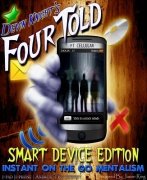 I knew when I saw the peformance of this in the video that not only was I going to buy it, but I also knew that it was going right into my do-at-any-time set and that I could kill with it. There's not much for me to add here except to say that Devin has improved on the original version. The use of the cellphone icons is genius. In fact, to do it impromptu, all you need is to download the JPG with the icons to your phone and get something to write on to keep track of the choices. (I'm really lazy. I carry a piece of paper that not only fulfills that purpose but has the crib pre-written on it so that I don't have to rely on my memory.) The principle used here is one that I've seen in Leo Boudreau's writings, which I refer to as "observational mentalism." (Boudreau's three ebooks, all available on lybrary, while not for beginners or the faint of heart, are absolute musts for the advanced/professional mentalist. His jaw-dropping routines will stop even the most knowledgable, savvy spectator--or mentalist--dead in his tracks because they look like honest-to-goodness real mind reading. Boudreau's processes are unknown to laypeople and just overall bewildering. But Four Told 2, fortunately, uses one of his easier to apply principles.) You will need a good performance, audience management, and the more spectators the better. And I would never do this with less than four spectators because you risk exposing the transparency of the process. But that said, this is not just water-cooler or Friday-night-at-the-bar mentalism. This is real deal stuff to make a reputation.
I knew when I saw the peformance of this in the video that not only was I going to buy it, but I also knew that it was going right into my do-at-any-time set and that I could kill with it. There's not much for me to add here except to say that Devin has improved on the original version. The use of the cellphone icons is genius. In fact, to do it impromptu, all you need is to download the JPG with the icons to your phone and get something to write on to keep track of the choices. (I'm really lazy. I carry a piece of paper that not only fulfills that purpose but has the crib pre-written on it so that I don't have to rely on my memory.) The principle used here is one that I've seen in Leo Boudreau's writings, which I refer to as "observational mentalism." (Boudreau's three ebooks, all available on lybrary, while not for beginners or the faint of heart, are absolute musts for the advanced/professional mentalist. His jaw-dropping routines will stop even the most knowledgable, savvy spectator--or mentalist--dead in his tracks because they look like honest-to-goodness real mind reading. Boudreau's processes are unknown to laypeople and just overall bewildering. But Four Told 2, fortunately, uses one of his easier to apply principles.) You will need a good performance, audience management, and the more spectators the better. And I would never do this with less than four spectators because you risk exposing the transparency of the process. But that said, this is not just water-cooler or Friday-night-at-the-bar mentalism. This is real deal stuff to make a reputation.